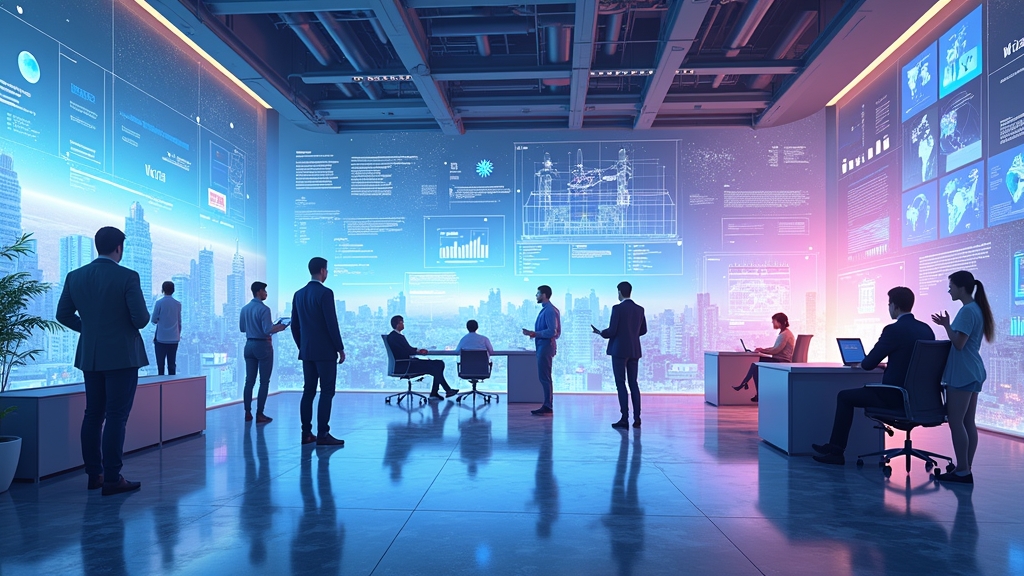Advertising
The Revolution of Workplace Reality Architects: Building the Future of Work in the Metaverse
Imagine a world where meetings don't take place in glass rooms, but in digital landscapes under the sky of Mars. Where collaborators from different continents share a virtual space as avatars, manipulating data holograms as if they were physical objects. This is not a scene from science fiction, but an emerging reality shaped by a new category of professionals: the architects of working realities.
These experts are designing corporate metaverses that transcend the traditional home office, creating ecosystems where productivity, creativity and human connection coexist in immersive environments. But how does this work in practice? What skills are needed? And, above all, how do you regulate a space that is still being invented?
We will explore this phenomenon in depth, from its origins to the legal and ethical challenges it presents.
What are Workplace Reality Architects and Why Did They Come About?
The pandemic has accelerated the adoption of remote working, but it has also revealed its limitations. Tiring video calls, lack of spontaneity in interactions and difficulty in maintaining the organizational culture are just some of the problems faced. It was in this context that companies like Microsoft and Target started investing in corporate metaverses.
Workplace architects are the professionals responsible for designing these environments. They combine knowledge of user experience design (UX), 3D programming, organizational psychology and gamification to create virtual spaces that simulate (and sometimes surpass) the dynamics of the physical office.
A practical example? Accenture already trains new employees in a metaverse called Nth Floorwhere they can interact with colleagues, take part in workshops and even receive mentoring in themed virtual rooms. It's not just a question of replacing face-to-face, but of reinventing it.
Advertising
But why is this role so crucial? Simple: a poorly designed metaverse can be as stressful as an endless Zoom meeting. If the environments are too complex, users get frustrated. If they are too simplistic, they lose engagement. The balance requires a multidisciplinary approach.
How Are Corporate Metaverses Being Used Today?
Some companies are already reaping the rewards of this technology. A NVIDIAfor example, uses its metaverse Omniverse to allow engineers to collaborate on 3D design projects in real time, regardless of their geographical location.
Another interesting case is that of Siemens, which has created a "digital twin" of its factories. Employees can inspect machines, simulate processes and identify faults before they happen in the real world. This not only increases efficiency, but also reduces travel and training costs.
But metaverses are not limited to industry. HR companies are using virtual environments to immersive recruitmentThis is where candidates take part in group dynamics, solve team challenges and even simulate day-to-day company situations.
And the benefits go beyond productivity. A study by PwC showed that employees who underwent virtual reality training retained up to four times more information than with traditional methods. When learning is experiential, the brain absorbs it better.
What skills does a Workplace Reality Architect need?
If you're thinking of entering this field, prepare yourself for a journey of constant learning. It's not enough to be good at design or programming; you need to understand how people interact with technology and with each other.
First, mastery of 3D creation tools such as Unity, Unreal Engine and Blender is essential. These platforms allow you to build realistic environments, from meeting rooms to fantastic scenarios for creative brainstorming.
Second, knowledge of UX/UI is fundamental. A metaverse must be intuitive. If users need a 30-minute tutorial to learn their way around the environment, something is wrong.
Third, notions of psychology and organizational behavior. How do people communicate in virtual environments? What elements encourage collaboration? A work reality architect needs to answer these questions.
Finally, gamification skills. Rewards, rankings and challenges can increase engagement. Salesforce, for example, uses gaming elements in its internal metaverse to encourage participation in training.
The Technical and Mass Adoption Challenges

Despite the potential, corporate metaverses still face significant obstacles. The necessary technology is not always accessible. High-quality virtual reality headsets are still expensive, and not all employees have high-speed internet.
Another problem is learning curve. People less familiar with technology can feel overwhelmed. Imagine a 50-year-old employee trying to navigate a 3D environment for the first time. If the experience is frustrating, they will simply reject the tool.
There is also the question of interoperability. If one company uses Horizon Workrooms (from Meta) and another uses Microsoft Mesh, how do they collaborate? The lack of universal standards can fragment the ecosystem.
And we can't ignore the digital analysis. Spending all day in a headset can cause eyestrain, headaches and even social isolation. How do you balance immersion and well-being?
The Dilemmas of Regulation in Corporate Metaverses
Here we enter murky territory. Who is responsible for online harassment? If an avatar harasses another in a corporate metaverse, should this be treated as a real crime?
Labor issues also arise. Should employees be paid for overtime spent on virtual training? And if an employee suffers an accident (such as a fall while using a headset), does this count as an accident at work?
In addition data privacy. Metaverses collect biometric information such as eye movements and facial expressions. Who has access to this data? How is it stored? A GDPR Europe is already adapting, but many countries still don't have specific legislation.
And what about intellectual property? If an employee creates a project in a corporate metaverse, who owns the idea? The company or the employee?
The Future: Where Will This Trend Take Us?
Corporate metaverses are still in their infancy, but their growth is inevitable. Companies such as IBM are already testing hybrid offices, where employees switch between face-to-face and virtual offices as needed.
In the future, we can hope:
– Integration with AIwhere virtual assistants guide new employees in immersive environments.
– Augmented reality in everyday lifewith holograms replacing physical screens.
– Virtual economieswhere employees are rewarded with tokens or NFTs for performance.
But the biggest challenge will be ensure that this evolution is inclusive. If only large corporations have access to these technologies, the gap between digital and traditional companies will only widen.
How can you prepare for this transformation?
If you're a professional, start familiarizing yourself with 3D creation and virtual reality tools. Courses such as those offered by Udemy or Coursera can be a good starting point.
If you are a company, try it. You don't have to build a whole metaverse at once. Start with small pilot projects, listen to feedback from employees and adjust the route.
And above all, take part in the discussion on regulation. The future of work is being written now, and we all have a voice in it.
What do you think? Are we ready to work in virtual worlds, or is there still a long way to go? Share your opinion and let's debate this future that has already begun.



